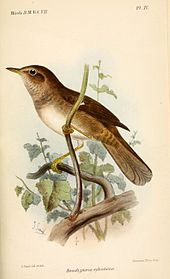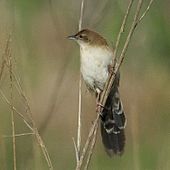Grass singer
| Grass singer | ||||||||||||
|---|---|---|---|---|---|---|---|---|---|---|---|---|

Strichelkopf reed climber ( Megalurus palustris ) |
||||||||||||
| Systematics | ||||||||||||
|
||||||||||||
| Scientific name | ||||||||||||
| Locustellidae | ||||||||||||
| Bonaparte , 1854 |
The grass warbler (Locustellidae, Syn .: Megaluridae) are a family of passerine birds (Passeriformes), which mainly consists of former representatives of the warblers (Sylviidae) and the timalia (Timaliidae). They include, among others, the grass warbler ( Locustella ) of the Old World (Europe, Africa and Asia), the scrub singer ( Bradypterus ) from Africa and Madagascar and the reeds Steiger ( Megalurus ) from Australasia and New Zealand. Depending on the systematic consideration, the family comprises 10 to 13 genera with 64 species, of which the genusLocustella makes up the largest proportion with 22 species.
features
The plumage of the grass warbler is generally brown and dashed in many genera. The wings are of medium length and rounded. The long tail is rounded and tiered. In the species of the genus Locustella , the under tail coverts are very long. The body is narrow to medium in size, cylindrical-ovoid and elongated. The medium-sized beak is thin and straight, but stronger in the Australian grass-singers. The head is medium in size. The neck is of medium thickness and length. Legs and feet are generally of medium length. The sexes are similar.
habitat
The grass warblers live in a wide variety of habitats, including forests with thick underbrush, marshland and marshland, and seasonally dry grasslands .
food
Most grass warbler species feed on insects and other invertebrates, especially spiders, small snails, worms, and amphipods. In some species, seeds enrich the food supply. The food is found by pecking in the thick undergrowth or on the ground.
Systematics
Locustellidae is a clade in the superfamily Sylvioidea . Before the family was largely genetically analyzed in 2006 and 2011, the majority of its representatives in the broader sense ( sensu lato ) were assigned to the warblers (Sylviidae). Locustellidae is a sister group of the families Bernieridae from Madagascar and Donacobiidae from South America, which consists of only one species, the reed spotter ( Donacobius atricapilla ).
Simplified cladogram according to Fregin et al., 2012:
|
|
|
||||||||||||
|
|
The family Megaluridae, which was established in 1875 by Edward Blyth , is often found in older systematics . These included the genera Megalurus , Cincloramphus and Eremiornis . Locustellidae was described by Charles Lucien Jules Laurent Bonaparte in 1854 and the eponymous genus Locustella by Johann Jakob Kaup in 1829. Therefore, the name Locustellidae is preferred according to the International Rules for Zoological Nomenclature (priority principle).
The International Ornithological Congress distinguishes the following eleven genera:
-
Grundsänger ( Robsonius ) (three species, whose representatives were previously assigned to the timalia )
- Rust-headed warbler ( Robsonius rabori ) (originally described as Napothera rabori )
- Sierra Madre basic singer ( Robsonius thompsoni )
- Brown-faced warbler ( Robsonius sorsogonensis )
-
Helopsaltes (six types)
- Sakhalin Schwirl ( Helopsaltes amnicola )
- Giant swirl ( Helopsaltes fasciolatus )
- Riedschwirl ( Helopsaltes pryeri ) (formerly Megalurus pryeri )
- Pleskeschwirl ( Helopsaltes pleskei )
- Striped swirl ( Helopsaltes certhiola )
- Middendorffschwirl ( Helopsaltes ochotensis )

-
Schwirle ( Locustella ) (21 or 22 species)
- Almond swirl ( Locustella mandelli ) (formerly Bradypterus mandelli )
- Locustella idonea ( split off from Locustella mandelli in 2015 by Alström et al. )
- Java swirl ( Locustella montis ) (formerly Bradypterus montis or Bradypterus seebohmi montis )
- Taiwan swirl ( Locustella alishanensis ) (formerly Bradypterus alishanensis )
- Sichuan swirl ( Locustella chengi )
- Himalayan swirl ( Locustella kashmirensis ) (formerly Bradypterus kashmirensis , was split off in 2008 by Alström et al. From Bradypterus thoracicus (now Locustella thoracica ))
- Spotted swirl ( Locustella thoracica ) (formerly Bradypterus thoracicus )
- Davidschwirl ( Locustella davidi ) (formerly Bradypterus davidi )
- Waldschwirl ( Locustella castanea ) (formerly Bradypterus castaneus )
- Long-tailed swirl ( Locustella caudata ) (formerly Bradypterus caudatus )
- Feldschwirl ( Locustella naevia )
- Cashmere swirl ( Locustella major ) (formerly Bradypterus major )
- Taczanowskischwirl ( Locustella tacsanowskia ) (formerly Bradypterus tacsanowskius )
- Hodgson's swirl ( Locustella luteoventris ) (formerly Bradypterus luteoventris )
- Schlagschwirl ( Locustella fluviatilis )
- Rohrschwirl ( Locustella luscinioides )
- Swallowtail Swirl ( Locustella lanceolata )
- Riedschwirl ( Locustella pryeri ) (formerly Megalurus pryeri )
- Luzon Schwirl ( Locustella seebohmi ) (formerly Bradypterus seebohmi or Bradypterus mandelli seebohmi )
- Borneoschwirl ( Locustella accentor ) (formerly Bradypterus accentor )
- Taliabu swirl ( Locustella portenta )
- Graubrustschwirl ( Locustella alfredi ) (formerly Bradypterus alfredi )

-
Bush warbler ( Bradypterus ) (12 species)
- Marsh warbler ( Bradypterus baboecala )
- Nigerian Marsh Warbler ( Bradypterus centralis ) (formerly Bradypterus baboecala centralis )
- Cinderella Warbler ( Bradypterus carpalis )
- Kivubush warbler ( Bradypterus graueri )
- Madagascar Bush Warbler ( Bradypterus brunneus ) (formerly Dromaeocercus brunneus )
- Cape warbler ( Bradypterus sylvaticus )
- Cinnamon Bush Warbler ( Bradypterus cinnamomeus )
- Lopesus Warbler ( Bradypterus lopezi )
- Bangwabush warbler ( Bradypterus bangwaensis )
- Barratt warbler ( Bradypterus barratti )
- Gabonese warbler ( Bradypterus grandis )
- Madagascar grass warbler or dwarf emu tail ( Bradypterus seebohmi ) (formerly Dromaeocercus seebohmi or Amphilais seebohmi )

-
Elaphrornis (a species)
- Ceylon warbler ( Elaphrornis palliseri )
-
Schoenicola (two types)
- Round-tailed Warbler ( Schoenicola platyurus )
- Nudist singer ( Schoenicola striatus ) (formerly Chaetornis striatus )

-
Catriscus (a species)
- Fan- tailed Warbler ( Catriscus brevirostris )
-
Reed climbers ( Poodytes ) (five species)
- White-winged reed climber ( Poodytes albolimbatus ) (formerly Megalurus albolimbatus )
- Spinifex warbler (
- † Chatham grass warbler ( Poodytes rufescens ) (extinct) (formerly Megalurus rufescens , Bowdleria rufescens or Bowdleria punctatus rufescens )
- New Zealand Fernbird ( Poodytes punctatus ) (formerly Megalurus punctatus or Bowdleria punctatus )
- Dwarf reed climber ( Poodytes gramineus ) (formerly Megalurus gramineus )
-
Megalurus (a species)
- Strichelkopf reed climber ( Megalurus palustris )
-
Cincloramphus (twelve species)
- Rustbump Lark Warbler ( Cincloramphus mathewsi ) (formerly Megalurus mathewsi )
- Black-bellied Lark Warbler ( Cincloramphus cruralis ) (formerly Megalurus cruralis )
- Rostkopf-Schilfsteiger ( Cincloramphus timoriensis ) (formerly Megalurus timoriensis )
- Papuan reed climber ( Cincloramphus macrurus ) (formerly Megalurus macrurus )
- New Caledonia Bush Warbler ( Cincloramphus mariei )
- Bismarck bush warbler or masked bush warbler ( Cincloramphus grosvenori ) (formerly Cichlornis grosvenori )
- Whitney Bush Warbler ( Cincloramphus whitneyi ) (formerly Cichlornis whitneyi )
- Bougainville warbler ( Cincloramphus llaneae ) (formerly Cichlornis llaneae )
- Maron Buschsänger ( Cincloramphus rubigenosus ) (formerly Ortogycichla rubigonosa )
- Long-legged Bush Warbler ( Cincloramphus rufus ) (formerly Trichocichla rufa )

-
Buettikoferella (a type)
- Timor Bush Warbler ( Buettikoferella bivittata )
The monotypic genus Malia , originally either to the families of the babblers (Timaliidae) and the bulbul (Pycnonotidae) was one, was based on a phylogenetic study of 2012, the Malia grata as Schwestertaxon of Cincloramphus timoriensis see Winkler et al. also placed in the family Locustellidae.
In 2018 the family Locustellidae was revised again. The new genus Helopsaltes was established for six Schwirl species (formerly Locustella ), which mainly occur in Asia . The genus Megalurulus has been synonymous with the genus Cincloramphus . The fan- tailed warbler was transferred from the genus Schoenicola to the monotypical genus Catriscus . The nudist singer (formerly in the monotypical genus Chaetornis ) was placed in the genus Schoenicola . The Madagascar grass warbler (formerly in the monotypic genus Amphilais ) was transferred to the genus Bradypterus . The reed climbers (formerly in the genera Megalurus or Bowdleria ) now form the genus Poodytes
literature
- David W. Winkler , Shawn M. Billerman & Irby J. Lovette : Bird Families of the World , The CornellLab of Ornithology & Lynx Edicions, Barcelona, 2015, ISBN 978-84-941892-0-3 , pp. 427-429
- Roger Safford , Frank Hawkins : The Birds of Africa: Volume VIII: The Malagasy Region. 2013, Bloomsbury Trade, ISBN 978-0713665321 , p. 723
- Per Alström ; Ericson, PGP; Olsson, U. & Sundberg, P. (2006): Phylogeny and classification of the avian superfamily Sylvioidea. Mol. Phylogenet. Evol. 38 (2): 381-397. doi : 10.1016 / j.ympev.2005.05.015 PMID 16054402 PDF full text
- Alström, P., S. Fregin, JA Norman, PGP Ericson, Leslie Christidis & U. Olsson: Multilocus analysis of a taxonomically densely sampled dataset reveal extensive nonmonophyly in the avian family Locustellidae. Mol Phylogenet Evol. 2011 Mar; 58 (3): 513-26. doi : 10.1016 / j.ympev.2010.12.012
Individual evidence
- ↑ a b Alström, P .; Ericson, PGP; Olsson, U. & Sundberg, P. (2006): Phylogeny and classification of the avian superfamily Sylvioidea. Mol. Phylogenet. Evol. 38 (2): 381-397. doi : 10.1016 / j.ympev.2005.05.015 PMID 16054402 PDF full text
- ↑ a b Alström, P., S. Fregin, JA Norman, PGP Ericson, L. Christidis, & U. Olsson: Multilocus analysis of a taxonomically densely sampled dataset reveal extensive nonmonophyly in the avian family Locustellidae. Mol Phylogenet Evol. 2011 Mar; 58 (3): 513-26. doi : 10.1016 / j.ympev.2010.12.012
- ^ A b Silke Fregin, Martin Haase, Urban Olsson, Per Alström: New insights into family relationships within the avian superfamily Sylvioidea (Passeriformes) based on seven molecular markers. BMC Evolutionary Biology 12 (1), 157, 2012. pp. 1-12
- ^ Sibley, CG, Monroe Jr., BL, 1990. Distribution and Taxonomy of Birds of the World. Yale University Press, New Haven.
- ↑ IOC World Bird List Grass Birds, Donacobius, Malagasy warblers, cisticolas & allies
- ↑ Per Alström , Canwei Xia, Pamela C. Rasmussen , Urban Olsson , Bo Dai, Jian Zhao, Paul J. Leader, Geoff J. Carey, Lu Dong, Tianlong Cai, Paul I. Holt, Hung Le Manh, Gang Song, Yang Liu, Yanyun Zhang and Fumin Lei: Integrative taxonomy of the Russet Bush Warbler Locustella mandelli complex reveals a new species from central China. Avian Research 6: 9; 2015. doi : 10.1186 / s40657-015-0016-z
- ↑ Alström, P., Rasmussen, PC, Olsson, U. & Sundberg, P .: Species delimitation based on multiple criteria: the Spotted Bush Warbler Bradypterus thoracicus complex (Aves: Megaluridae). Zoological Journal of the Linnean Society, 154, 2008: 291-307. doi : 10.1111 / j.1096-3642.2008.00418.x
- ↑ Oliveros, CH, Reddy, S. & Moyle, RG: The phylogenetic position of some Philippine “babblers” spans the muscicapoid and sylvioid bird radiations. Molecular Phylogenetics and Evolution 65, 2012, pp. 799-804
- ↑ David W. Winkler, Shawn M. Billerman & Irby J. Lovette: Bird Families of the World, The CornellLab of Ornithology & Lynx Edicions, Barcelona, 2015, ISBN 978-84-941892-0-3 , pp. 427-429
- ↑ Per Alström, Alice Cibois, Martin Irestedt, Dario Zuccon, Magnus Gelang, Jon Fjeldså, Michael J. Andersen, Robert G. Moyle, Eric Pasquet, Urban Olsson: Comprehensive molecular phylogeny of the grassbirds and allies (Locustellidae) reveals extensive non- monophyly of traditional genera, and a proposal for a new classification , Molecular Phylogenetics and Evolution, 2018 doi : 10.1016 / j.ympev.2018.03.029